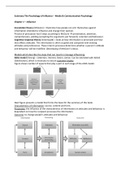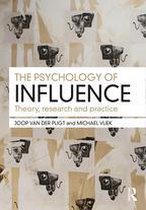Summary The Psychology of Influence – Media & Communication Psychology
Chapter 1 – Influence
Inoculation theory (McGuire) = illustrates how people can arm themselves against
information intended to influence and change their opinion.
Process of persuasion has 6 steps according to McGuire → presentation, attention,
comprehension, yielding (accepting the arguments put forward), retention and behaviour.
Cognitive response theory (Greenwald) = looks at how information is processed and how
that affects attitudes. This information is often coupled and compared with existing
attitudes and preferences. These interim processes determine whether a person’s attitude
and behaviour will be modified. (Developing of McGuire’s ideas).
Models which describe the steps that can result in message influencing
AIDA model (Strong) = Attention, Interest, Desire, Action. Can be extended with AIDAS
(Satisfaction), which is necessary to assure customer loyalty.
Figure shows number of aspects that play a part in each stage of the AIDA model.
Next figure presents a model that forms the basis for the summary of this book.
Characteristics of information: source, content and form.
Processing: the influence of the characteristics of information on attitudes and behaviour is
dependent on how the recipient processes the information.
Outcome: to change people’s attitudes and behaviour.
,The various forms of processing can be presented as a continuum (see figure below).
On the left side: ‘system 2’ (analysis and reasoning).
Right side: ‘system 1’ (automatic).
Chapter 2 – attitudes and behaviour
Attitudes = people’s evaluative responses to a stimulus (attitude object, can be a person,
organization, situation, etc.).
Measuring attitudes is hard. Attitudes are not directly observable (latent variable).
Example:
You start with the attitude object → this invokes an attitude. This is not visible, but can be
deduced from the response we do see to the object through non-verbal signals, verbal
statements or actions.
Three components of attitudes
• Cognitions (beliefs, opinions). The cognitive response consists the thoughts aroused by
particular characteristics of the attitude object → form an evaluative judgement about it
(positive or negative).
• Affect (feelings, emotions). Can be expressed through verbal and non-verbal
communications or through physiological response. These are often instinctive reactions.
• Behaviour (actions, conduct). Consumer buying habits, helping someone you like etc.
See figure next page:
Behaviour is the consequence of the cognitive
and affective response to an attitude object. But
behaviour can also influence the cognitive and
affective response to an attitude object.
The affective and cognitive components of an
attitude are often closely related.
, The five characteristics of attitudes
• They focus on an object, person, organization or event.
• They are evaluative, either positively or negatively.
• They can be based, either in whole or in part, on cognitive beliefs about characteristics of
the attitude object.
• They can be based, either in whole or in part, on affective responses to the attitude
object.
• They have repercussions for behaviour towards the attitude object.
The weight of the underlying components of behaviour can vary. Some attitudes are more
the product of the affective response, other attitudes are more reasoned.
To influence people to exercise more, it is more persuasive to communicate affective
information rather than cognitive information.
Reasoned attitudes are those based upon conscious consideration of all the costs and
benefits.
Less reasoned are more instinctive.
Dual-process models
Different ways to process information.
Elaboration likelihood model (ELM) = state that there are two ways in which people’s
attitudes or other judgements can be formed or modified: either with a high degree of
thought (extensive analysis of costs and benefits, think critically), or a relatively low degree
of thought (process available information superficially).
ELM states that people can form or change their attitudes based on more or less elaboration
of the available information.
Whether you process information through central or peripheral route depends on time
available and the person’s motivation and ability to analyze all the arguments presented.
Factor that makes people more motivated: self-relevance of the issue.
, The two routes to persuasion in the ELM
• Central route to persuasion: Attitudes are formed or modified after thorough
consideration and analysis of the core characteristics of the attitude object.
• Peripheral route to persuasion: Attitudes are formed by drawing on characteristics of
the attitude object or the situation which are only indirectly relevant for the issue at
hand. Source of information.
Heuristic-systematic model (HSM) = states that you can process information in two ways,
heuristic and systematic. Can happen at the same time.
Differences between ELM and HSM
ELM treats the level of processing as a continuum of mutually exclusive routes. In the HSM
both routes can be taken simultaneously and may be mutually influential.
Dual process model (Kahneman) = draws a distinction between two complete systems,
system 1 is intuitive and quick, and system 2 it is analytical and relatively slow.
System 1: information processing happens parallel rather than serially → so the resulting
intuitive judgements are generated more quickly, require less effort and are based largely
upon associative processes.
Need for cognition (NfC) = the extent to which someone takes pleasure in the thorough
consideration and analysis of information.
A low score on the NfC scale means that someone has a lack of mental enjoyment and hence
less need to process information actively.
High scorers on the scale are more influenced by the quality of arguments, whilst low scorers
are swayed more by the number of arguments presented and attractiveness of the
information source.
Strong attitudes are often based upon reasoned, cognitive consideration and are held in
respect of subjects that matter to the person concerned. Such strong attitudes often have
clear behavioral repercussions.
Intuitive attitudes (system 1) are more instinctive. → Affect and emotions are thus more
prominent in system 1 than in system 2.





